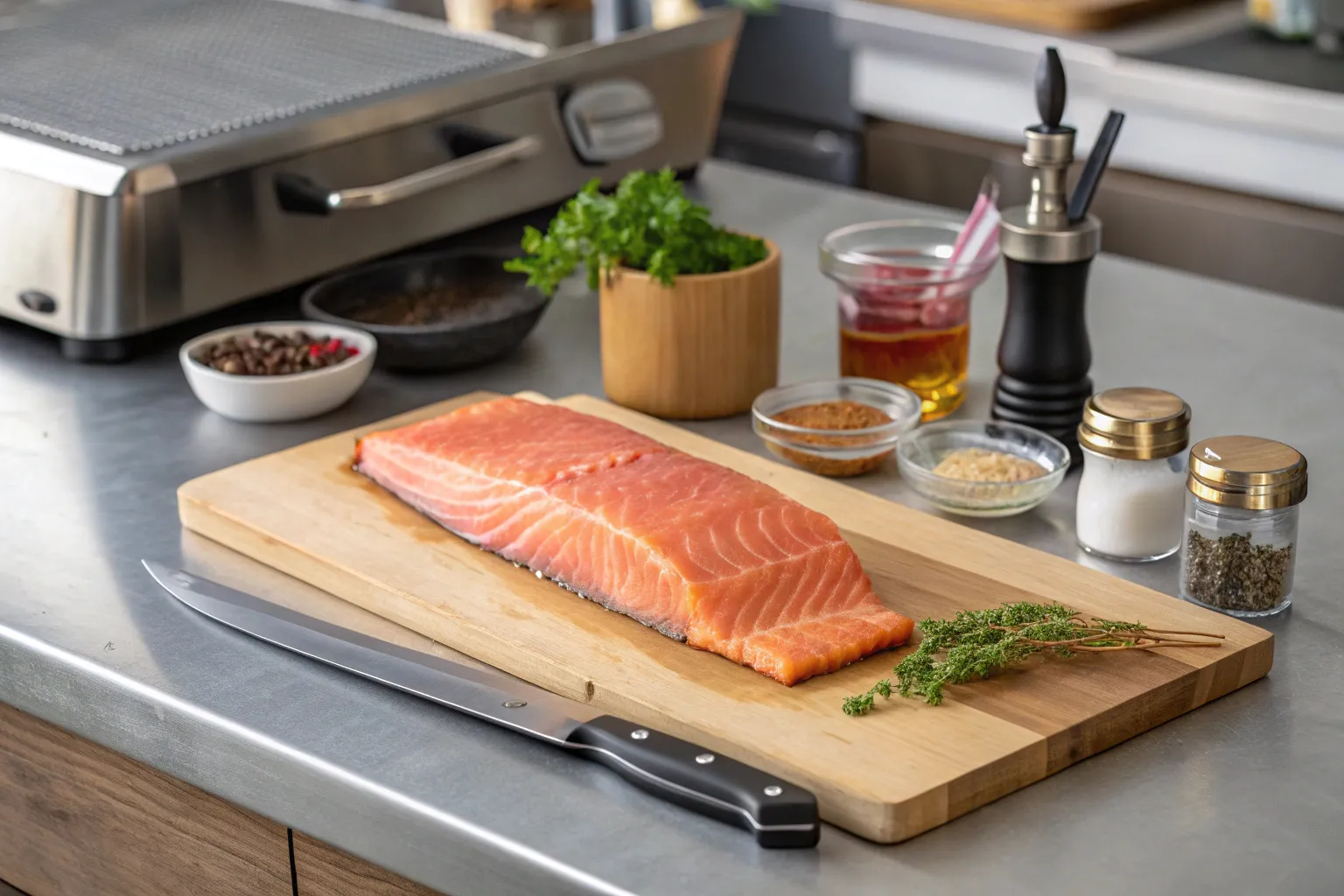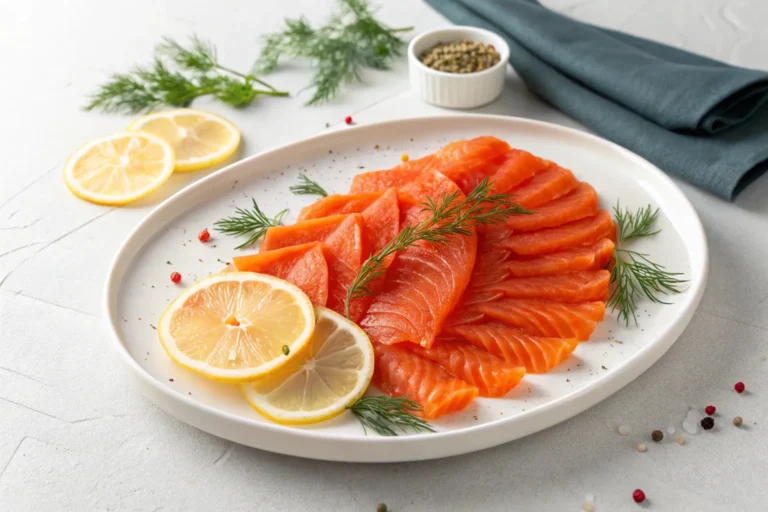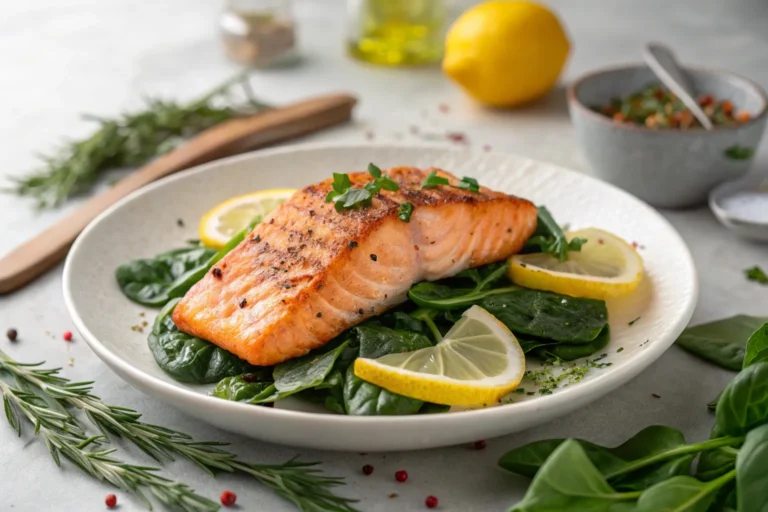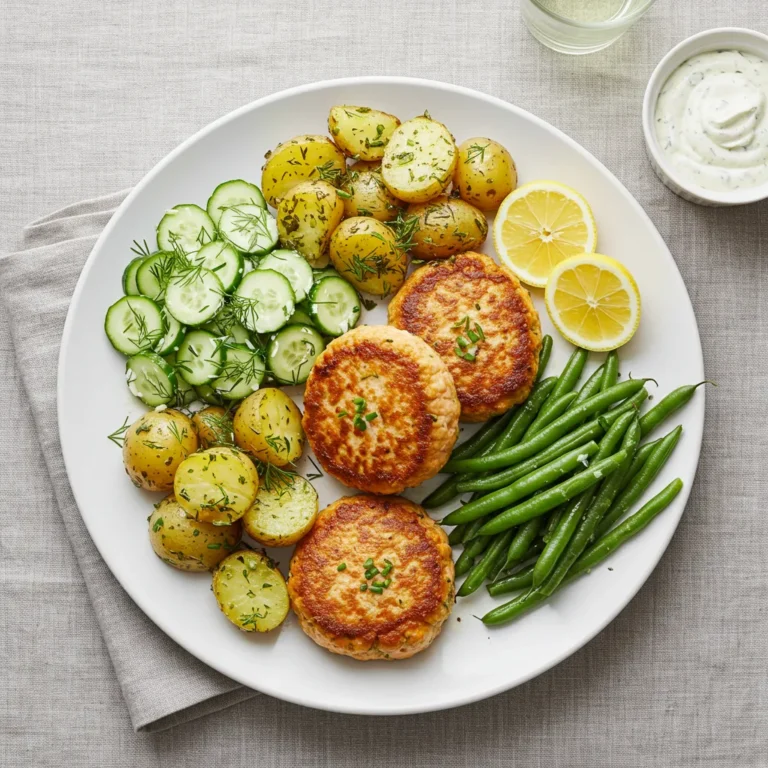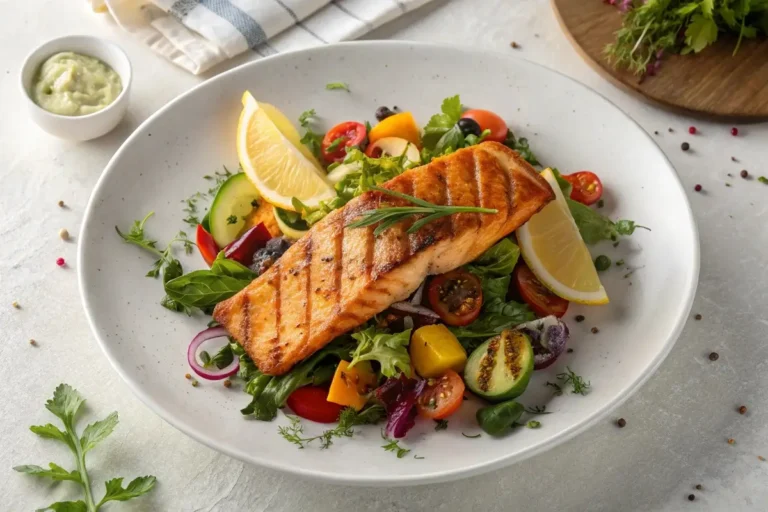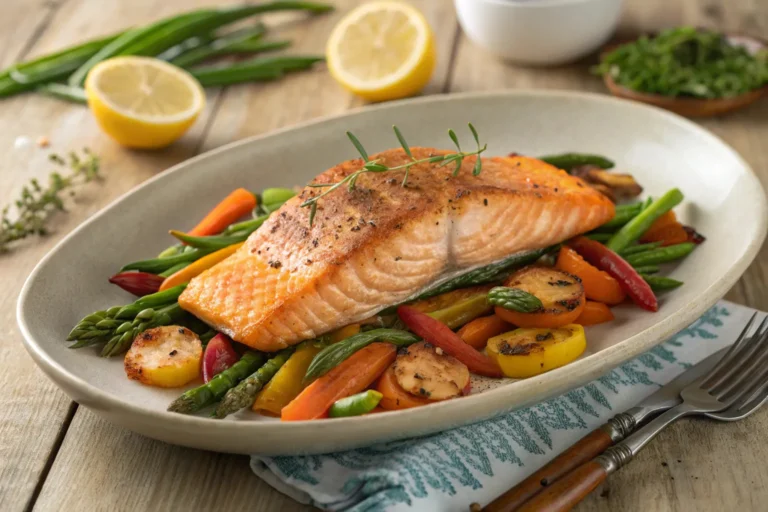How Long to Smoke Salmon at 250°F: The Perfect Guide
Are you ready to turn ordinary salmon into a delicious treat that will wow everyone? Smoking salmon at 250°F is an art that needs precision and the right temperature control.
I’ve spent hours mastering the smoked salmon temperature and time. The secret to amazing hot-smoked salmon is keeping the temperature at 250°F. Knowing how long to smoke it is key to getting the perfect flavor and texture.
In this guide, I’ll show you how to smoke salmon step by step. You’ll learn about choosing the right salmon, brining, and picking the best wood. You’ll discover how to make smoked salmon that rivals restaurant quality in your kitchen.
Table of Contents
Understanding the Basics of Hot Smoking Salmon
Hot smoked salmon is a tasty dish that turns fresh fish into a mouthwatering treat. As a home cook, I’ve learned that to make great hot smoked salmon, you need to know the basics of smoking.
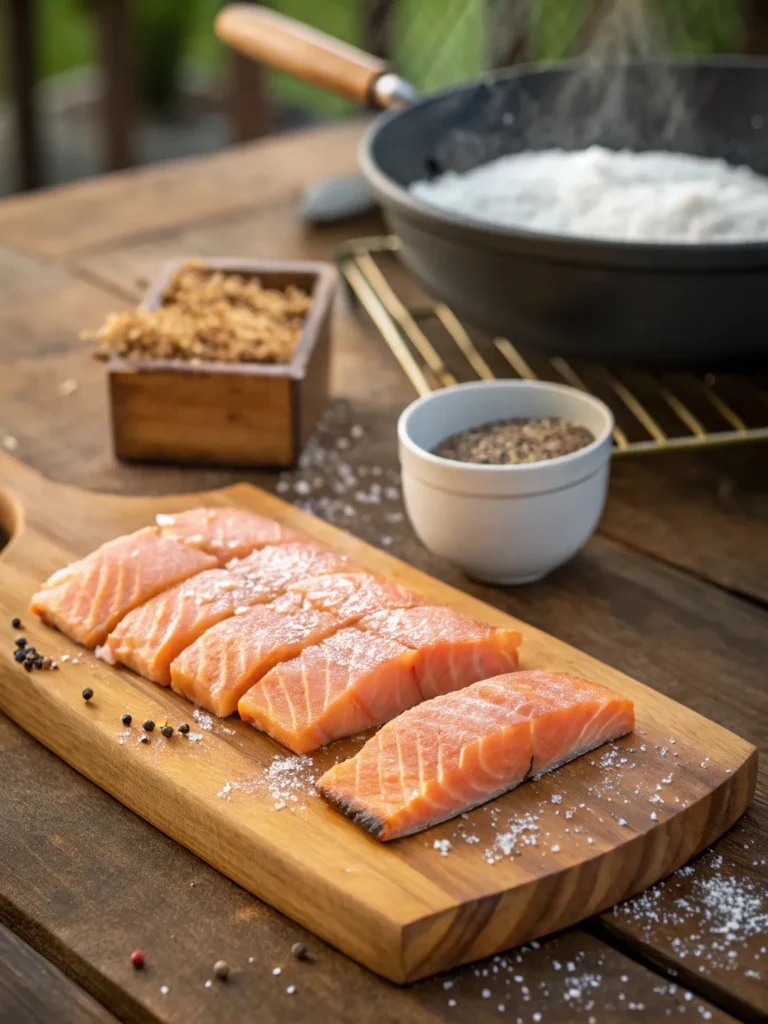
Different Types of Smoking Methods
There are many ways to smoke salmon, each giving different tastes and textures. The main methods are:
- Cold Smoking: Low temperature method (typically under 90°F)
- Hot Smoking: Higher temperature technique (between 120-250°F)
- Warm Smoking: Intermediate temperature range
Why Choose Hot Smoking at 250°F
The best temperature for smoking salmon is 250°F. This temperature cooks the salmon fast, kills off bad bacteria, and adds a deep smoky flavor.
Essential Equipment Needed
To make great hot smoked salmon, you need the right tools. Here’s a list of what you’ll need:
| Equipment | Purpose |
|---|---|
| Electric or Charcoal Smoker | Primary cooking device |
| Digital Meat Thermometer | Temperature monitoring |
| Wood Chips | Flavor infusion |
| Brining Container | Salmon preparation |
| Cooling Rack | Post-smoking resting |
Learning these basics will help you make delicious hot smoked salmon. It’s sure to wow your family and friends.
Preparing Your Salmon for the Perfect Smoke
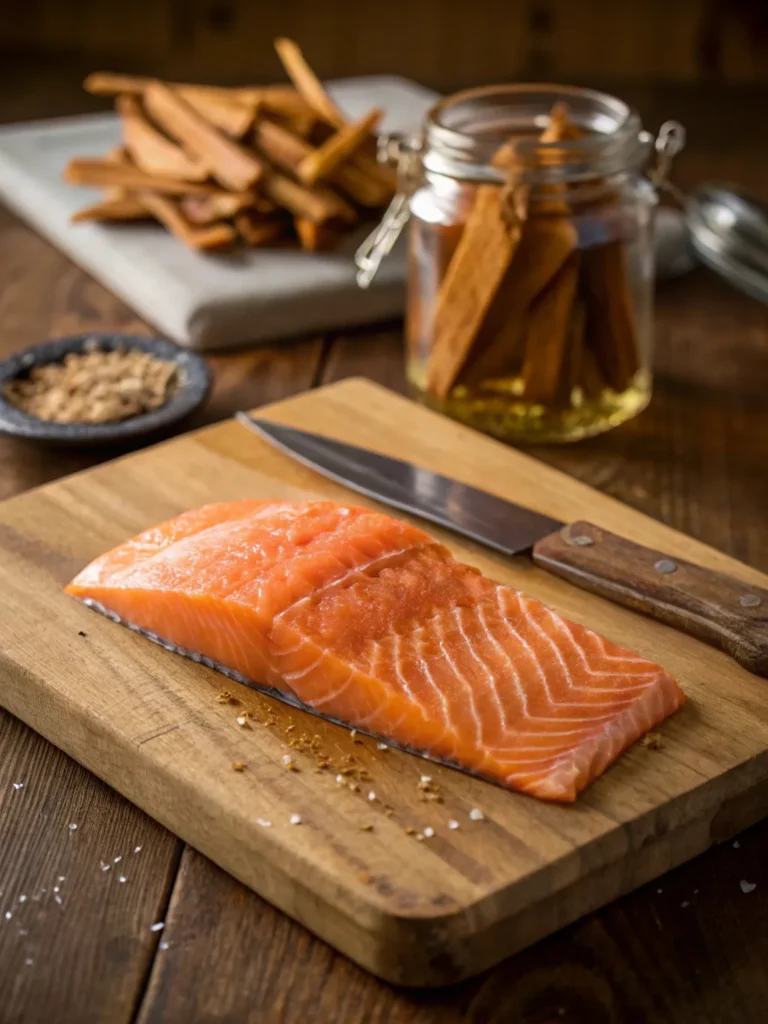
Starting a salmon smoking guide means getting ready for delicious recipes. First, pick the best salmon. Look for fresh, high-quality fish with firm flesh and a clean smell.
Before you smoke it, there are a few important steps:
- Clean the salmon under cold water
- Remove scales with a fish scaler or knife
- Trim off any extra fat or dark meat
- Pat the salmon dry with paper towels
For the best smoking recipe, try these extra steps:
- Fillet the salmon for even pieces
- Keep the skin on for moisture
- Cut against the grain for tenderness
Seasoning is key in your salmon guide. Make a simple dry rub or brine to enhance the salmon’s taste. A mix of kosher salt, brown sugar, and black pepper is great for most smoking methods.
| Salmon Preparation Stage | Key Considerations |
|---|---|
| Freshness Check | Bright color, firm flesh, ocean smell |
| Cleaning | Remove scales, trim excess fat |
| Cutting | Even pieces, against the grain |
| Seasoning | Simple dry rub or brine recommended |
Pro tip: Always handle salmon with clean hands and use a sharp, dedicated fish knife for the best results in your smoking process.
The Best Salmon Cuts for Smoking at 250°F
Choosing the right salmon for smoking at 250°F is key to a great dish. Different cuts have their own traits that affect cooking time and taste.
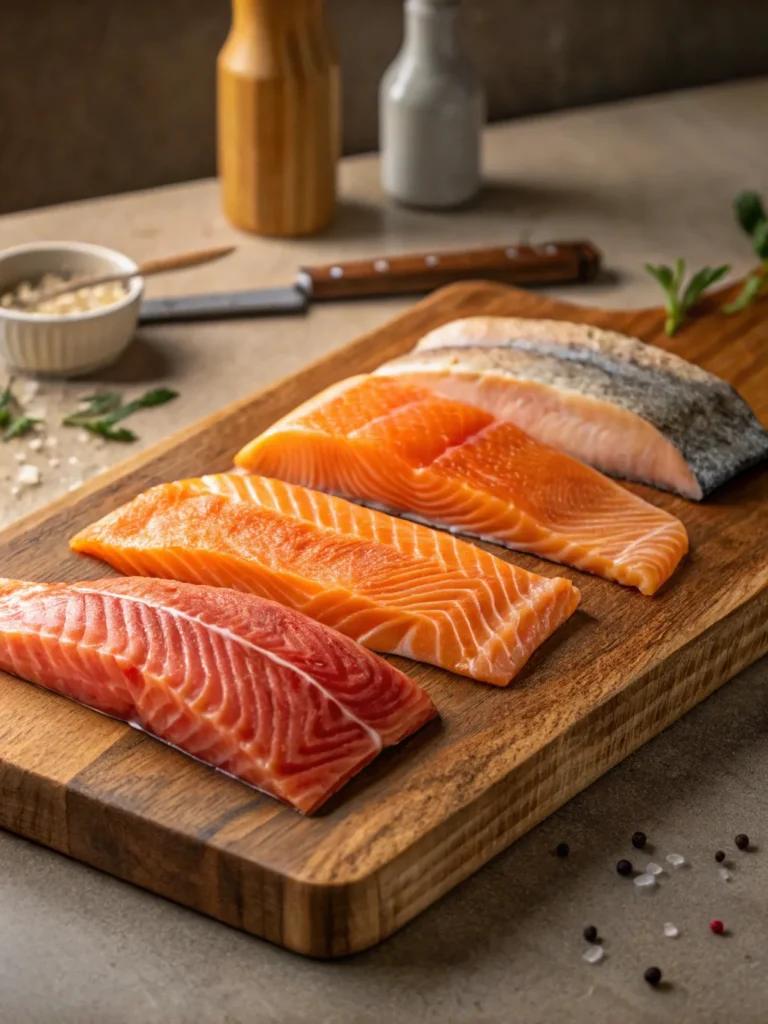
When you’re ready to smoke salmon, knowing about different types is important. I’ll help you pick the best cut for your needs.
Wild vs. Farm-Raised Salmon
Deciding between wild and farm-raised salmon involves several factors:
- Wild salmon has a stronger taste
- Farm-raised salmon has consistent fat
- Wild salmon is leaner
- Farm-raised salmon is cheaper
Ideal Thickness and Size
For the best smoking at 250°F, follow these thickness tips:
| Salmon Cut | Ideal Thickness | Recommended Smoking Time |
|---|---|---|
| Fillet | 1-1.5 inches | 2-3 hours |
| Steak | 1.5-2 inches | 3-4 hours |
| Whole Side | 2-3 inches | 4-5 hours |
Quality Indicators to Look For
When picking salmon for smoking, look for these quality signs:
- Bright, vibrant color
- Firm flesh with no discoloration
- Fresh, ocean-like smell
- Minimal signs of bruising or damage
Pro tip: Always buy salmon from trusted fishmongers or seafood markets for the best quality.
How Long to Smoke Salmon at 250°F
Smoking salmon at 250°F needs precision and careful timing. The time it takes to smoke salmon depends on several important factors. These factors affect the texture and flavor of your fish.
Thickness is key when figuring out how long to smoke salmon. Thinner fillets need less time, while thicker ones require more. This ensures they are cooked just right.
- Thin salmon fillets (½ inch): 2-3 hours
- Medium salmon fillets (1 inch): 3-4 hours
- Thick salmon cuts (1.5 inches): 4-5 hours
Using an internal temperature probe is a good idea. It helps ensure your salmon reaches a safe 145°F. This is important for both food safety and flavor.
| Salmon Thickness | Smoking Time | Target Internal Temp |
|---|---|---|
| ½ inch | 2-3 hours | 145°F |
| 1 inch | 3-4 hours | 145°F |
| 1.5 inches | 4-5 hours | 145°F |
Pro tip: Always let your smoked salmon rest for 15-20 minutes after cooking. This lets the juices redistribute, making it moist and flavorful.
Creating the Perfect Brine for Smoked Salmon
Brining is key to a great salmon smoking recipe. As a home chef, I’ve found that a good brine can turn simple salmon into a dish to remember. This guide will show you how to make a brine that boosts flavor and keeps the salmon moist.
Salt is vital in preparing salmon for smoking. The brine adds flavor and keeps the fish moist during smoking.
Essential Brine Ingredients
- Kosher salt: The main curing agent
- Brown sugar: It balances salt and adds depth
- Water: Makes the brine solution
- Optional flavor enhancers:
- Garlic powder
- Black pepper
- Dill
- Maple syrup
Brining Duration Guidelines
| Salmon Thickness | Brining Time | Salt Concentration |
|---|---|---|
| 1/2 inch | 2-3 hours | 10% salt solution |
| 1 inch | 4-6 hours | 15% salt solution |
| 2 inches | 8-12 hours | 20% salt solution |
Advanced Brining Techniques
For more complex recipes, try adding white wine, apple juice, or herb-infused waters to your brine. These can make your smoked salmon truly special.
Remember, making great smoked salmon takes patience and attention to detail. Take your time, measure everything carefully, and feel free to try new flavors.
Monitoring Internal Temperature for Safety and Doneness
It’s important to track the smoked salmon temperature for a tasty and safe dish. Chefs stress the need for precise temperature control. I’ll show you how to check your salmon’s internal temperature correctly.
When smoking salmon at 250°F, knowing the right time and temperature is vital. The fish’s internal temperature affects both its safety and taste.
Critical Temperature Ranges
- Safe minimum temperature: 145°F for fully cooked salmon
- Medium doneness: 135°F to 140°F
- Medium-rare doneness: 125°F to 130°F
Use a digital meat thermometer with a thin probe for accurate readings. Insert it horizontally into the thickest part of the salmon. This way, you avoid piercing the whole fillet.
| Doneness Level | Internal Temperature | Texture |
|---|---|---|
| Rare | 120°F | Very soft, translucent |
| Medium-Rare | 125-130°F | Slightly firm, moist |
| Medium | 135-140°F | Firmer, flaky texture |
| Well-Done | 145°F | Completely opaque, firm |
Remember, salmon cooks a bit more after it’s removed from heat. Pull it out about 5°F before your target temperature. This helps avoid overcooking.
Tips for Achieving the Perfect Smoke Flavor
Creating the ultimate hot smoked salmon needs careful attention to wood selection and smoke intensity. I’ve learned through years of experience that the right approach can transform an ordinary piece of fish into a culinary masterpiece.
Choosing the best wood is key when smoking salmon at 250°F. Not all woods are the same, and your choice can greatly impact the flavor of your hot smoked salmon.
Top Wood Choices for Salmon Smoking
- Alder Wood: Traditional choice with a mild, sweet flavor that complements salmon perfectly
- Apple Wood: Provides a subtle, fruity smoke that enhances the fish’s natural taste
- Cherry Wood: Offers a slightly sweet and mild smoke profile
- Maple Wood: Adds a gentle, sweet undertone to the salmon
Mastering Smoke Intensity
Controlling smoke intensity is an art form when preparing hot smoked salmon. I recommend starting with a light smoke and gradually building flavor. The best temperature to smoke salmon allows for precise control over smoke density.
- Use fewer wood chips for a delicate smoke flavor
- Soak wood chips in water to reduce burning and control smoke
- Monitor the color and density of the smoke
- Avoid thick, white smoke that can make salmon bitter
Pro tip: Experiment with wood combinations to create unique flavor profiles that will elevate your hot smoked salmon from good to extraordinary.
Common Mistakes to Avoid When Smoking Salmon
Smoking fish at 250f needs precision and careful attention. Many home cooks make mistakes that can ruin the salmon. One big mistake is not controlling the temperature well.
Keeping the heat steady is key for the right texture and flavor.
Another mistake is overcooking the salmon. It’s important to watch the cooking time to avoid dry fish. Use a meat thermometer to check the internal temperature. Aim for 145°F for the best taste and moisture.
Choosing the wrong wood can also mess up your smoking. Not all woods go well with salmon. Fruit woods like apple or cherry are milder, while woods like mesquite are stronger. Pick the right wood and use it in the right amount for a balanced flavor.
Not brining the salmon enough is another common error. A good brine adds flavor and keeps the fish moist. Spend time making a good brine. Let the salmon soak in it before smoking. With practice, you’ll get better at smoking salmon at home.
FAQ
How long does it take to smoke salmon at 250°F?
Smoking salmon at 250°F takes 2 to 4 hours. Thinner fillets need about 2 hours. Thicker cuts might take up to 4 hours. Always check the fish’s internal temperature with a meat thermometer. It should reach 145°F for safety.
What type of wood is best for smoking salmon?
Use mild, sweet woods like apple, cherry, or alder for salmon. These woods add a delicate flavor that complements the fish. Avoid strong woods like mesquite, as they can make the salmon taste bitter.
Do I need to brine salmon before smoking?
Brining is recommended but not necessary. A good brine seasons the fish, keeps it moist, and prevents drying out. A basic brine includes water, salt, and optional flavors like brown sugar or herbs.
What’s the difference between hot and cold smoking salmon?
Hot smoking (like the 250°F method) fully cooks the salmon to 145°F. Cold smoking keeps the temperature low and doesn’t fully cook the fish. Hot smoking is safer and easier for home cooks.
Can I smoke frozen salmon?
It’s best to thaw salmon before smoking. Thaw it in the fridge overnight and pat it dry before seasoning or brining. This ensures even smoking and prevents food safety issues.
How do I know when my smoked salmon is done?
Check the internal temperature with a meat thermometer. Salmon is ready when it reaches 145°F. Look for opaque, flaky flesh that separates easily with a fork. The fish should be golden-brown and slightly glossy.
How long can I store smoked salmon?
Smoked salmon can last 3-4 days in the fridge in an airtight container. Freeze it for up to 3 months for longer storage. Always refrigerate within two hours of cooking and wrap it tightly to maintain quality.
What’s the best type of salmon for smoking?
King (Chinook) and Sockeye (Red) salmon are great for smoking due to their fat content and flavor. Wild-caught salmon often tastes better than farm-raised, but both can be successfully smoked.
Did this recipe work for you? We’d love to hear how it turned out!
There are no reviews yet. Be the first one to write one.

